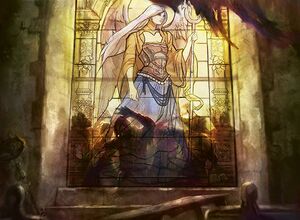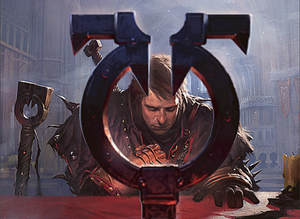Church of Avacyn: Difference between revisions
| Line 14: | Line 14: | ||
Can it be definitive that Avacyn is gone? | Can it be definitive that Avacyn is gone? | ||
What used to be the most powerful weapon in the struggle for survival of mankind, today has abandoned them, leaving the Church powerless to contain the dark forces of Innistrad. | What used to be the most powerful weapon in the struggle for the survival of mankind, today has abandoned them, leaving the Church powerless to contain the dark forces of Innistrad. | ||
===Church and State=== | ===Church and State=== | ||
In Innistrad, church and state are deeply interdependent; there is virtually no separation of the two. | In Innistrad, church and state are deeply interdependent; there is virtually no separation of the two. | ||
Revision as of 16:47, 18 February 2018


The symbol that represents the religion of humanity on Innistrad is the Church of Avacyn. [1] [2] [3]
Description
The central figure of the church is Avacyn itself, an archangel so pure and extremely powerful that she was able to contain Innistrad's darkness and give humans the faith of true eternal rest-in-peace.
Until recently, the presence of Avacyn was so decisive that faith in her gave real power to the clergy and other faithful, a power that pushed back creatures of evil. The blessed silver weapons could destroy the worst horrors and very powerful runes marked with her symbol protected entire villages. The effectiveness of the church was concrete and visible, a welcome weapon in a world of atrocities.
However, the Archangel Avacyn has not been seen in several seasons, and her absence is starting to be felt with the advancement of darkness. Since Avacyn has disappeared, the prayers were not enough to prevent terrible attacks of werewolves to remote villages. Sacred symbols were unable to stop the vampires from taking advantage of travelers passing through the mountains. The dead are not protected against tampering and resuscitation of the flesh ... alchemists, necromancers and ghoulcallers now act carelessly.
Not even the elders of the church, including Mikaeus, the "Ruling Lunarch" have said a word about what may have happened to Avacyn.
Can it be definitive that Avacyn is gone? What used to be the most powerful weapon in the struggle for the survival of mankind, today has abandoned them, leaving the Church powerless to contain the dark forces of Innistrad.
Church and State
In Innistrad, church and state are deeply interdependent; there is virtually no separation of the two.
Local governments rely on the power of the Church to keep order and maintain public safety. Often the rule of law is adjudicated by the prelature, lawyers and judges ordained by the Church. All education is handled by the Church, although different sects sometimes establish their own schools and training grounds. Except for merchants and artisans, all professions are part of the Church. Even merchants and artisans are governed by fellowships, which must be sanctioned by the Church.
Theological Principles
Faith in the church of Avacyn actually works, but there are no formulas that are consistently successful. Saying the mystical words in the right combination will result in protective magic, but some days it works better than others. And sometimes the evil it's warding against is more powerful than other times. The unreliability of the wards and blessings has led to disagreements over dogma. Although there is still only one church, sects have emerged over disagreements about the right way to do things. The goal of the church is safety, not perfection. Humans want to live in reasonable safety until they die, and then they want to remain peacefully in their graves. Cremation is forbidden because it is believed to result in a restless, angry spirit.
In the Church of Avacyn, there is no conception of heaven and hell. The humans of Innistrad do not believe in a heavenly afterlife to reward their past deeds. And their equivalent of hell is a very literal thing: there are actual cracks in the ground where demons dwell. Avacyn is not expected to eliminate evil in the world or to create a perfect life for everyone. Instead, she is the font of safety and protection. She is the authority to whom the faithful must go before something bad happens, to help ward off those evils that have always been a part of the world.
Church Hierarchy
Avacyn
The archangel Avacyn is the focal point of the human's worship. She is believed to be the source of all protective magic. It is thought that she controls the seasons and is the force that brings an end to the long and bleak Hunter's Moon. Adherents to Avacyn are called Avacynians, and their church is the Church of Avacyn, or the Avacynian Church.
Avacyn's Host

The archangel Avacyn has a host of angels who serve her.
- The Flight of Goldnight — These angels are associated with the sun, in contrast with Avacyn herself. Once a year during the Harvest Moon season, the sun will not dip below the horizon for two full days, and during this time the moon isn't visible. Known as the Feast of Goldnight, this is the holiest day for the humans. It is the time when the Avacynian enchantments are strongest throughout Innistrad. This flight of soldier-angels lives on the Elgaud Grounds.
- The Flight of Alabaster — These angels personify the Blessed Sleep and are associated with the Hunter's Moon season. They provide magic that wards against the desecration of dead humans and live in the lofts of Thraben Cathedral.
- The Flight of Herons — These are the angels of birth and purity and are associated with the New Moon season. Their magic is said to ward humans against harm in life (as opposed to the Alabaster host, which wards against harm in death).
Clerical Ranks
- Lunarch — The head of the church. This is a position elected by the council of bishops. It used to be held by a man named Mikaeus, who was killed and turned into a zombie.
- Bishop — The highest order of clergy. They reside in the cathedral at Thraben as members of the Thraben Council, the governing body of the church. Each province has its own bishop, and a handful of other senior priests fill out the rest of the council.
- Mayor — The political leader of a parish. He or she has a mix of administrative and religious duties, but the day-to-day administration is left to the priests.
- Elder — A senior citizen. A council of elders sometimes replaces the mayor.
- Priest — Priests oversee the church and attend to parishioners' needs. They all use mana to weave spells, but with varying degrees of skill.
- Monk — These wandering priests are the lowest order of clergy. Some have been sanctioned by the church to seek out people living alone in the wilderness. But many are fanatics who are no longer formally part of the hierarchy, having said the wrong thing or enforced the wrong dogma and been cast out.
Cathars
Cathars are the holy warriors of the Church.[4] The regiments are trained on the Elgaud Grounds in Nephalia.
- Gavony Riders. The elite cavalry of Innistrad, extensively trained in mounted combat with swords and lances.
- Mausoleum guards. The rank-and-file soldiers of the cathars, wielding little magic but making up for it with their numbers.
- Midnight duelists. Soldiers that patrol the streets, particularly at night, on the lookout for thieves, vampires, and corpse traders.
- Moor chaplains. Battlefield faithful who wield magic and weapons with equal skill. Their magic focuses on healing and protection, so they don’t usually fight on the front lines.
- Gryffbond Order — Cathars of the Gryffbond Order, or simply the gryff-knights, are a type of cathar dedicated to mounted combat in the skies. Their gryffs seem naturally suited to mounted combat, as their agility and poise translate into a smooth but maneuverable ride. Gryff-knights are paired off one-to-one with their gryff companions and stay with that union until one of them dies.
- Inquisitors — Inquisitors are cathars who can be hired out to come help a parish if they have a particular problem with vampires or devils.
- During Avacyn’s absence, the inquisitors led a series of brutal forays into Kessig and the Gavony Moorland. They executed suspected lycanthropes with little or no proof, and punished accused heretics in unsanctioned trials. With Avacyn’s madness, this savage form of inquisition has become the norm, and inquisitors who still pry into dark mysteries have become a minority.
- Knight-Inquisitor of Saint Raban. Taking their name from the legendary investigator and slayer of werewolves, these cathars serve as inquisitors in the classic sense, investigating mysteries and secrets.
- Parish-blades — Cathars stationed in parishes serve as escorts along roads or protect the cathedral in Thraben. This is an ordained military force that assembles whenever the clergy demands.
- The Quiver of Kessig. An order split off from the parish-blades. Its members specialize in archery and long-range defense, and often guard town walls and church roofs against spirits, vampires, specters, demons, and other flying attackers.
Avacynian Archmages
The Avacynian archmages are gifted spellcasters with the inborn ability to channel some of the divine power of the archangels.[4] Each lineage of the archmages practices unique techniques passed down from master to student for generations, ultimately tracing back to the archangels and Avacyn herself.
- Spearsages. The archmages of Goldnight, use powerful and aggressive spells associated with the sun, channeling blinding rays of holy light and powerful prayers to bolster their allies’ speed and courage.
- Moonsages. The archmages of Alabaster, are concerned with preserving the Blessed Sleep, preventing humans from returning as zombies. They use preventative and warding spells, banishing the undead to the void and making sure graves remain sealed.
- Springsages. The archmages of Herons, are healers who use their magic to aid individuals, whole villages, and even the land itself. They act much like wandering priests or monks, traveling the remote reaches to minister to the people and heal the sick.
Church Artisans
- Devisers — Architects and magical engineers.
- Lunar-smiths — Blessed weapons are an important part of Avacynian magic, and these clergy are trained in the art of weapon-making. Certain blessings must be said at certain times during the forging process to make a weapon magically effective against a particular foe. Silversmiths are particularly revered because of the difficulty in imbuing the silver with strong magic, especially anti-lycanthropic magic.
- Runechanters — Runechanters are a specialized branch of the clergy that specializes in engraving blessings on material objects, including weapons. Everything from swords to axes to children's toys has words written on it in an effort to protect its owner. The best runechanters can write so small that hundreds of these blessings can be squeezed into a small space.
Lunarch Council
After Lunarch Mikaeus died during the siege of Thraben, and his successor Macher was killed in the early days of Avacyn's madness[5], a Lunarch Council was established, made up of senior bishops of the church with a few cathar leaders in advisory positions. This council was exposed to be controlled by the Skirsdag. [6]
Post-Avacyn's Betrayal
Due to Nahiri's machinations, Avacyn and most other angels became insane and began killing the people of Innistrad. This lead to a mass crisis of faith and a severe fragmentation of the church: a central branch that became a full-blown inquisition, and the Order of Saint Traft. The members of the inquisition, led by Seeta, were partly eldrazified and called themselves the 'sinpurged', claiming the transformation was the result of the sin being purged from their bodies.[7]
Notable members
- Avacyn
- Arlinn Kord
- Grete
- Mikaeus, the Lunarch
- Odric
- Saint Traft
- Saint Trogan, the Slayer
- Thalia
- The three angelic sisters